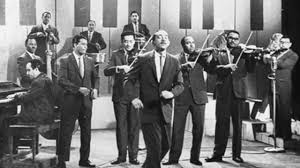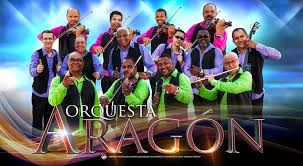LA ORIGINAL ORQUESTA ARAGÓN DE CIENFUEGOS Y SU SÓN TRADICIONAL. VIDEOS.
La popular Orquesta Aragón fundada en Cienfuegos en 1939 por Orestes Aragón Cantero con el nombre de Rítmica 39; luego se llamaría Rítmica Aragón y finalmente Orquesta Aragón.
La Orquesta Aragón de Cuba, representa y da nombre a las Charangas que aparecieron en el Caribe cuando despuntaba el siglo XX. Su sonido característico es el son tradicional con su sección rítmica africana y las melodías españolas, sobre las cuales agregan tres violines.
La Orquesta Aragón, no solo fue popular por interpretar el son, sino que también fue inspiradora del mambo y fue fundada por Orestes Aragón de profesión carpintero. En tiempos del Cha cha cha, La Charanga Eterna se adueñó de ese ritmo e hizo famoso al inolvidable flautista Rafael Egües, quien estuvo en la orquesta hasta 1984, logrando éxitos como El Bodeguero, Nosotros y Pare Cochero.
En cuanto a sus cualidades como conjunto: Es propio de la sonoridad de la Aragón, la definición de los planos rítmicos y melódicos. Cada uno de los instrumentos tiene bien definida su función musical, complementándose unos a otros, lo cual se plasma desde los arreglos musicales […], constituyendo la base de la sincronización y timbre característico de esta agrupación.»
La Aragón comenzó un programa en Radio Progreso que aún se sigue transmitiendo y a medida que su música crece, crece su popularidad.
Sus primeros integrantes fueron:
Orestes Aragón Cantero, director y contrabajo (sustituído en 1948 por Rafael Lay como director)
Efraín Loyola, flauta
Rufino Roque, piano
Orestes Varona, timbal
Noelio Morejón, güiro
Filiberto Depestre, primer violín
Hilario Candelario y René González, segundo violín (hasta 1940, sustituídos luego por Rafael Lay)
Pablo Romay, cantante.
CORTA HISTORIA DE LA ORQUESTA.
Actuaban en la radioemisora CMHD, de Cienfuegos, y tocaron su primer baile el 9 de octubre de 1939. En 1940 entró a la orquesta Rafael Lay, en sustitución de Hilario Candelario y René González.
En 1941, Francisco Arboláez (Panchito), sustituyó en el güiro a Noelio Morejón, y en 1945 se incorporó a la orquesta como ejecutante de la tumbadora, Guido Sarría. En 1948, por enfermedad de Aragón, asumió la dirección de la orquesta Rafael Lay y en 1950 la orquesta realizó su primer viaje a La Habana. En mayo de 1953 Loyola formó su propia agrupación, y lo sustituyó en la flauta Rolando Lozano, y posteriormente Richard Egües. Ingresó también José Antonio Olmo (Pepe), quien sustituyó a Pablo Romay.
El 7 de agosto de 1955 La Aragón, se instaló definitivamente en La Habana, contratada por la Cerveza Cristal, con objeto de grabar un programa diario en Radio Progreso. Si en un principio su repertorio estaba compuesto por danzones, boleros, guarachas y otros géneros de la música cubana, con el triunfo del chachachá, La Aragón se convirtió en la principal intérprete de este género, al que llevó a su más refinado nivel creativo e instrumental.
El 8 de febrero de 1956 realizó su primer viaje al exterior, Panamá; en 1957 actuaron en los carnavales de Venezuela; en 1958 hicieron una gira por Guatemala y Estados Unidos.
En 1959 se incorporó a la orquesta Rafael Bacallao (Felo).
En 1963 ingresaron en la orquesta Dagoberto González, violín; Alejandro Tomás Valdés, cello; más adelante Guillermo García sustituyó a Guido Sarría en la tumbadora, y en 1980 entró en la agrupación Rafael Lay Bravo como violinista. En 1982 falleció Rafael Lay Apesteguía, y asumió la dirección de la Aragón Richard Egües, hasta 1984, cuando Rafael Lay Bravo tomó en sus manos esta responsabilidad. También han sido miembros de la orquesta Aragón en diferentes etapas: René Lorente, flauta; Orlando Pérez, contrabajo, Julio Iznaga y Blas Egües, timbal; Justo Emilio Rueda, cantante.
En 1965 la Aragón formó parte del Music Hall que realizó una gira por varios países de Europa: Unión Soviética, Polonia, República Democrática Alemana, Francia; participó en los festivales de jazz Colombes, Calais, Chalon-sur-Saone y Royal Festival Hall, Inglaterra.
La Aragón también actuó en Colombia, Puerto Rico, México, Nicaragua, Chile, República Dominicana, Jamaica, Islas Guadalupe, Aruba, Martinica, Canadá, Estados Unidos, Japón, Grecia, Italia, Hungría, Checoslovaquia, Inglaterra, Finlandia, Egipto, Líbano, Sierra Leona, Angola, Costa de Marfil, Congo Brazzaville, Mali, Argelia, Tanzania, Benin, Guinea Bissau y Guinea Conakry. Fue nominada al Grammy Latino por La charanga eterna, mejor álbum tropical tradicional 2002.
En algo más de 60 años La Orquesta Aragón ha interpretado varios éxitos como El Bodeguero, El cerquillo, Cachita, Pare Cochero, Guajira con tumbao, Tres lindas cubanas.
Rafael Lay quien fue su director desde 1948, falleció en 1982 en un accidente de tránsito, pero la orquesta continúa su función, la de hacer gozar a todo el mundo bajo la dirección de Rafael Lay hijo.
La Orquesta Aragón con un CD de longevo nombre: La Charanga Eterna fue nominada al Premio Grammy Latino. Y el CD Con tremenda sabrosura, en la categoría de mejor álbum tropical contemporáneo en el 2009, junto a afamados músicos como Chucho Valdés y X Alfonso.
THE ORIGINAL ARAGÓN ORQUESTA DE CIENFUEGOS AND ITS TRADITIONAL SONG. VIDEOS.
The popular Aragon Orchestra founded in Cienfuegos in 1939 by Orestes Aragón Cantero with the name of Rhythmic 39; then it would be called Ritmica Aragón and finally Orquesta Aragón.
The Aragon Orchestra of Cuba represents and gives its name to the Charangas that appeared in the Caribbean when the 20th century began. Its characteristic sound is the traditional son with its African rhythmic section and the Spanish melodies, on which three violins are added.
The Aragón Orchestra was not only popular for interpreting the son, but it was also an inspiration for the mambo and was founded by Orestes Aragón, a carpenter by profession. In Cha cha cha times, La Charanga Eterna took over that rhythm and made the unforgettable flute player Rafael Egües famous, who was in the orchestra until 1984, achieving successes such as El Bodeguero, Nosotros and Pare Cochero.
As for its qualities as a whole: It is typical of the sound of the Aragon, the definition of the rhythmic and melodic planes. Each one of the instruments has its musical function well defined, complementing each other, which is reflected in the musical arrangements […], constituting the basis of the timing and characteristic timbre of this group. »
La Aragón started a program on Radio Progreso that is still broadcasting and as its music grows, its popularity grows.
SHORT HISTORY OF THE ORCHESTRA.
They performed on the CMHD radio station in Cienfuegos and played their first dance on October 9, 1939. In 1940 Rafael Lay entered the orchestra, replacing Hilario Candelario and René González.
In 1941, Francisco Arboláez (Panchito) replaced Noelio Morejón in the güiro, and in 1945 he joined the orchestra as a performer of the tumbadora, Guido Sarría. In 1948, due to Aragon’s illness, he assumed the direction of the Rafael Lay orchestra and in 1950 the orchestra made its first trip to Havana. In May 1953 Loyola formed his own group, and he was replaced on the flute by Rolando Lozano, and later by Richard Egües. José Antonio Olmo (Pepe) also entered, replacing Pablo Romay.
On August 7, 1955, La Aragón settled permanently in Havana, hired by the Cerveza Cristal, in order to record a daily program on Radio Progreso. If at first her repertoire was made up of danzones, boleros, guarachas, and other genres of Cuban music, with the triumph of chachachá, La Aragón became the main interpreter of this genre, which she brought to her most refined creative level and instrumental.
On February 8, 1956, she made her first trip abroad, Panama; in 1957 they performed at the carnivals in Venezuela; in 1958 they toured Guatemala and the United States.
In 1959 Rafael Bacallao (Felo) joined the orchestra.
In 1963, Dagoberto González, violin, entered the orchestra; Alejandro Tomás Valdés, cello; Later Guillermo García replaced Guido Sarría in the tumbadora, and in 1980 Rafael Lay Bravo joined the group as a violinist. In 1982 Rafael Lay Apesteguía died, and Richard Egües took over the management of the Aragon until 1984, when Rafael Lay Bravo took this responsibility into his hands. They have also been members of the Aragón orchestra at different stages: René Lorente, flute; Orlando Pérez, double bass, Julio Iznaga and Blas Egües, timpani; Justo Emilio Rueda, singer.
In 1965 Aragon was part of the Music Hall, which toured several countries in Europe: Soviet Union, Poland, German Democratic Republic, France; participated in the jazz festivals Colombes, Calais, Chalon-sur-Saone and Royal Festival Hall, England.
La Aragón also performed in Colombia, Puerto Rico, Mexico, Nicaragua, Chile, Dominican Republic, Jamaica, Guadalupe Islands, Aruba, Martinique, Canada, United States, Japan, Greece, Italy, Hungary, Czechoslovakia, England, Finland, Egypt, Lebanon, Sierra Leone, Angola, Ivory Coast, Congo Brazzaville, Mali, Algeria, Tanzania, Benin, Guinea Bissau, and Guinea Conakry. She was nominated for a Latin Grammy for La charanga Eterna, the best traditional tropical album in 2002.
In just over 60 years, the Orquesta Aragón has performed several hits such as El Bodeguero, El cerquillo, Cachita, Pare Cochero, Guajira con tumbao, Tres lindas cubanas.
Rafael Lay, who was its conductor since 1948, died in 1982 in a traffic accident, but the orchestra continues its function, that of making everyone enjoy under the direction of Rafael Lay Jr.
The Aragon Orchestra with a long-lived CD: La Charanga Eterna was nominated for the Latin Grammy Award. And the CD Con tremenda sabrosura, in the category of the best contemporary tropical album in 2009, along with famous musicians such as Chucho Valdés and X Alfonso.
Agencies/ Wiki / Ecured/ Internet Photos/ YouTube/ Arnoldo Varona/ www.TheCubanHistory.com
THE CUBAN HISTORY, HOLLYWOOD.











